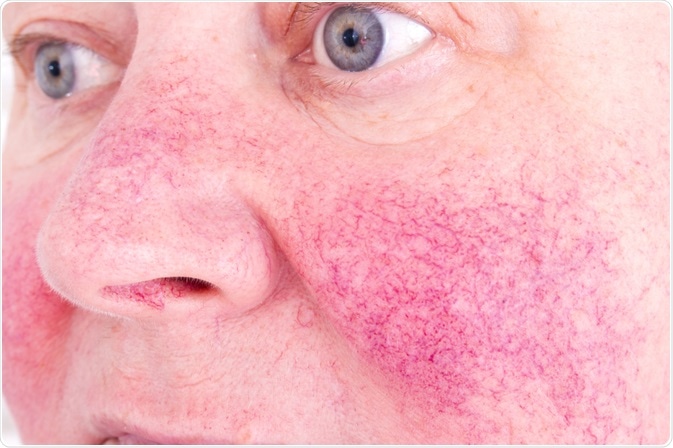Secondary to rosacea, rhinophyma is a skin disorder that causes the nose to become red, bumpy, and enlarged.

Image Credit: Lipowski Milan / Shutterstock.com
What is rhinophyma?
The nose can become severely affected by rosacea. Initially, the nose becomes red and shiny and appears bumpy. Then, blood vessels start to become prominent and there is a progressive thickening of the skin leading to hypertrophy or enlargement of the nose. Eventually, the nose becomes deformed, with the formation of a nodule-like structure over it.
This condition is known as rhinophyma, where "phyma" means swelling or bulb, whereas the word "rhino" denotes the nose. This rhinophyma, alongside other features such as puffy, flushed cheeks and red, swollen eyes combine to give a characteristic rosacea appearance.
Rhinophyma primarily affects middle-aged or elderly Caucasian males. The lower two-thirds of the nose are more commonly affected than the upper one-third.
Types of rhinophyma
There are several types of rhinophyma, which include glandular rhinophyma, fibroangiomatous rhinophyma, and actinic rhinophyma.
Glandular Rhinophyma
Glandular rhinophyma refers to an enlargement of the sebaceous glands over the nose. To note, sebaceous glands secrete an oily substance called sebum that maintains suppleness of the skin and prevents its drying.
The surface of this type of rhinophyma is pitted or indented and the swelling is asymmetrical. When the skin surface is compressed between the fingers, there may be secretion or oozing of sebum, along with dead skin cells and bacteria. The nasal skin may acquire a secondary bacterial infection that can lead to complications such as scarring.
Fibroangiomatous rhinophyma
Fibroangiomatous rhinophyma is a condition that causes the nose to turn red or copper in color. The nose appears to be edematous with visible veins on its surface and there may be pustules across the surface.
Actinic rhinophyma
Actinic rhinophyma involves the development of nodules of elastic tissue across the nose.
Other phymas
In addition to rhinophyma, there may be other phymas or enlargements and deformities of facial features including the following:
- Chin (gnathophyma)
- Forehead (metophyma)
- Ears (otophyma)
- Eyelids (blepharophyma)
Treatment
Treatment options for rhinophyma include surgical resection of the skin lesions which may involve electrocautery, cryosurgery, and laser ablation. Whereas electrocautery involves the destruction of the affected tissues with electrically generated heat, cryosurgery instead destroys the tissues with extremely cold temperatures. Finally, laser ablation destroys the affected tissues with laser beams.
Surgery, however, may cause excessive bleeding, pain, and deformity of the nose.
Reference
- http://www.rosacea.org/pdf/gradingsystem.pdf
- http://www.nejm.org/doi/pdf/10.1056/NEJMicm1208058
- https://laserderm.com.au/
- http://onlinelibrary.wiley.com/doi/10.1111/j.1473-2165.2009.00456.x/abstract
Further Reading
Last Updated: Jan 12, 2023